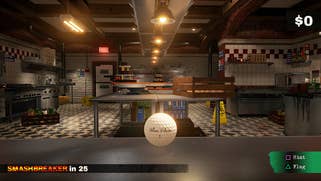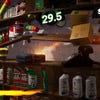Face-Off: Dangerous Golf
Are all three versions up to par?
Combining classic score-driven gameplay with next-generation physics, Dangerous Golf offers a unique blend of old and new ideas that have almost nothing to do with actual golf. At its core, you'll spend most of your time guiding a flaming golf ball around in slow motion while smashing everything in the environment for points. Yes, it's a simple concept but one that truly comes alive thanks to its robust physics engine and challenging gameplay.
Each level focuses on a single room littered with all manner of objects, gadgets and furniture. Objects placed throughout the level are each assigned pre-defined physics properties designed to enable some explosive situations. Realistic physics are nothing new, but the sheer number of objects present in any given scene combined with the complexity of the interactions is what comes to define this game.
Wood splinters, glass shatters, and cloth burns. It may not always behave realistically, but the results are always entertaining. You could, for instance, have a multi-layered serving cart with bottles of champagne stacked on top while a collection of fine china rests on the bottom shelf. Each of these items are stacked together until your flaming golf ball makes its way onto the cart. The direction and force of impact are taken into account in order to determine break points, reactions, and velocity. The resulting debris, then, can start a chain reaction with surrounding objects to further increase your score.
Maximising your damage on every bounce is key to succeeding in the game and the physics engine is the central pillar that ties it all together. That's not to say all of this destruction is procedural - there are obvious break points present in many of the objects, for instance, but the way in which those pieces blow apart remains convincing and fun nonetheless.
If you're playing Dangerous Golf on the PC, it's also possible to utilise Nvidia's Flex - a particle-based physics simulation that enables even more complex and detailed interactions. In this game, that translates into additional effects including increased debris and a proper fluid simulation. Smash into a can of paint or a bucket of water and you'll actually see the resulting liquid arc realistically through the air - a visual element missing from the base game.
Dangerous Golf can look phenomenal in motion but those physics don't come cheap, and that quickly becomes evident in its performance metrics - the console versions target 30fps. For a game constrained to a series of smaller rooms, this is initially disappointing, but the reality is that the types of calculations performed here are likely pushing the meagre console CPUs to the limit. Some of this work can be offloaded to the GPU using compute shaders but it's clear that the physics simulation is highly demanding on both platforms.
Furthermore, while 30fps is adequate in this case, fluidity is further compromised by improper frame-pacing. It's an issue that has popped up regularly since the beginning of this generation, most famously in Bloodborne and Dark Souls 3, and it continues to manifest in a number of games today. As a refresher, when we discuss frame pacing, it's simply in reference to the length of time that individual frames are displayed on screen. At 30fps, each frame should persist for 33ms for proper frame pacing. Improper frame pacing, however, often sees instances where some frames persist for 16ms, others for 33ms, and others still for 50ms. This inconsistency leads to noticeable judder tht disrupts what would otherwise be a stable level of performance. Fortunately, the development team are aware of this issue and are currently investigating.












This is also an issue on PC when the game is played with the default 30fps cap but thankfully, you can remove this in the options menu. Once unlocked, general performance on our test PC was remarkably stable on our overclocked Core i7 5820K paired with a GTX 970. Even with Nvidia Flex pushed to its maximum setting, 60fps was no problem at 1080p.
That said, perhaps the cap exists for users sporting less capable CPUs. We've run across a number of complaints suggesting that performance isn't particularly stable using a GTX 970 - something that may be down to CPU utilisation. We monitored CPU usage while playing and determined that CPU scaling works very effectively here with a reasonably even distribution of tasks across available threads. Less powerful CPUs may struggle to keep up - but this proved difficult to ascertain during testing - we disabled four cores (eight threads) with the Core i7 5820K and limited it to 3.3GHz, effective emulating a dual-core Haswell set-up. Frame-rates dropped a little and utilisation obviously increased, but we saw nothing untoward in terms of gameplay. However, audio would start to drop out when CPU utilisation hit 75 per cent - and this is an issue that has been noted by other users.
Beyond that, AMD users also miss out on the more advanced physics made possible with Flex - after installing an AMD R9 290X in place of the 970, we were unable to take advantage of the feature at all. Basically, for best performance and the complete set of PC visual feature, you're going to want a fast CPU coupled with an Nvidia graphics card.
That's not the end of our PC issues either. One of the more curious omissions here is the lack of support for mouse and keyboard input. While it's not clear how well it would function with a mouse, it is the platform's standard input device and should be supported. Even games that ship with their own peripherals, such as Activision's Guitar Hero, still include support for the standard gamepad after all. Even more disappointing, the game appears to only support Xbox 360 and Xbox One gamepads - we were unable to play the game with a Dual Shock 4 (even with Input Mapper active) or the Steam Controller, for instance.
There are a few other platform differences to note as well. On PlayStation 4, users are treated to a full 1080p presentation that looks excellent here. Xbox One, on the other hand, is limited to 800p, resulting in a blurrier overall appearance. This is somewhat offset by Unreal Engine 4's effective temporal anti-aliasing solution, but it's clear that texture and distant detail is lacking on Microsoft's platform in comparison. Anisotropic filtering is at least adequate on all platforms.
Beyond image quality, we also observed slight differences in shading between the two platforms. The PC version enjoys a higher density of breakable objects. Loading up the kitchen stage on all three platforms, for instance, reveals a greater number of items placed across the scene - something that could seemingly impact the scoring system. The Xbox One version features even fewer objects than the PlayStation 4 version.
Then we have shadows, which are largely absent throughout the game. In certain stages, select objects feature shadows, but that doesn't apply to the majority of the scenery. What few shadows are present in the game are further pared back on Xbox One, where they appear to be completely eliminated in every scene. This is further exacerbated by the lack of ambient occlusion across the environment. With the complexities of the simulation, we understand the need to cut back on this and, in most environments, it doesn't significantly detract from the presentation, but it would have been nice to see a more complete implementation on the PC.
One final issue we have with the game centres on loading screens. While individual load times are not overly lengthy, you do run across them quite regularly. Restarting a map, exiting to the main menu, and selecting a new map all require players to wait ten to twenty seconds. When going for the highest score, the inability to quickly retry can become troublesome in later stages.
Dangerous Golf - the Digital Foundry verdict
Dangerous Golf lacks a touch of polish on all three platforms but it remains a recommended purchase - put simply, this is an incredibly fun and beautiful-looking game. In a world where online gaming has all but eliminated local multiplayer, it's nice to have a release like Dangerous Golf which revels in it. That said, there is a learning curve here and not all players will immediately be able to grasp what is happening. Comments on various discussion forums, at least, suggest that some users just aren't getting it. However, anyone familiar with Burnout's crash mode should be able to pick up and play right off the bat.
And there's something else that deserves highlighting too. The physics model here really is exceptional - to the point where Dangerous Golf showcases physics that we hope to see deployed one day in larger scale games. Imagine playing a game such as Battlefield with a level of destruction and physical interactions on par with Dangerous Golf. It would be quite a sight indeed but if the requirements here are anything to go by, it may be a while before we get there.
If you're interested in checking out the game, we should stress that in our experience, it plays well on all three platforms - but there are certain considerations that need to be taken into account. Hardware permitting, the PC version offers the best performance, but limited support for input devices and the appearance of bugs (such as audio drop out) for some users could be a real issue here. The good news is that Three Fields Entertainment is aware of the issues and has pledged to address them. On the other hand, the two console versions have no such problem - but both currently exhibit frame-pacing issues. Between the two, the PlayStation 4 definitely has the visual advantage with a higher resolution and more refined visuals making that the best option. Whichever version you decide to play, Dangerous Golf is a great, score-driven experience the likes of which we just don't see very often these days. If you enjoyed Burnout's crash mode and miss games like Tony Hawk's Pro Skater, give it a shot.








